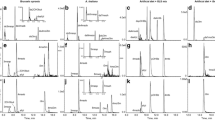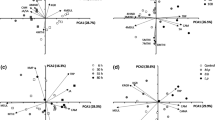Abstract
Brassica nigra plants, characterized by high levels of sinigrin, and artificial aphid diets to which sinigrin was selectively added were used to rear the crucifer specialist, Brevicoryne brassicae. Aphids were provided as a food source to two species of polyphagous ladybird, Adalia bipunctata and Coccinella septempunctata. First instar A. bipunctata were unable to survive when fed with B. brassicae reared on B. nigra or diets containing 0.2% sinigrin, but when fed with aphids reared on diets containing 0% sinigrin, survival rates were high. By contrast, first instar C. septempunctata were able to survive when fed with aphids reared on B. nigra or artificial diets containing up to 1% sinigrin. However, the presence of sinigrin in the aphid diet decreased larval growth and increased the time necessary for larvae to reach second instar for this species of ladybird. These results indicate that the presence of sinigrin in the diet of B. brassicae makes this aphid unsuitable as a food source for A. bipunctata but not for C. septempunctata, although for this ladybird species, there appear to be costs associated with feeding on aphids that contain this secondary metabolite.
Similar content being viewed by others
References
Acheampong, S., and Stark, J. D. 2004. Can reduced rates of pymetrozine and natural enemies control the cabbage aphid, Brevicoryne brassicae (Homoptera: Aphididae), on broccoli? Int. J. Pest Manag 50:275–279.
Blackman, R. 1967. The effects of different aphid foods on Adalia bipunctata L. and Coccinella 7-punctata L. Ann. Appl. Biol 59:207–219.
Bones, A. M., and Rossiter, J. T. 1996. The myrosinase-glucosinolate system, its organisation and biochemistry. Physiol. Plantarum 97:194–208.
Bones, A. M., and Rossiter, J. T. 2006. The enzymic and chemically induced decomposition of glucosinolates. Phytochemistry 67:1053–1067.
Bridges, M., Jones, A. M. E., Bones, A. M., Hodgson, C., Cole, R., Bartlet, E., Wallsgrove, R., Karapapa, V. K., Watts, N., and Rossiter, J. T. 2002. Spatial organization of the glucosinolate-myrosinase system in brassicae specialist aphids is similar to that of the host plant. Proc. Royal Soc. London 269:187–191.
Dadd, R. H. 1967. Improvement of synthetic diet for the aphid Myzus persicae using plant juices, nucleic acids, or trace metals. J. Ins. Physiol 13:763–778.
Dawson, G. W., Griffiths, D. C., Pickett, J. A., Wadhams, L. J., and Woodcock, W. M. 1987. Plant-derived synergists of alarm pheromone from turnip aphid, Lipaphis (Hyadaphis) erysimi (Homoptera, Aphididae). J. Chem. Ecol 13:1663–1671.
Francis, F., Haubruge, E., and Gaspar, C. 1999. Effects of isothiocyanates on the glutathione S-transferases activity from Adalia bipunctata L. (Coleoptera: Coccinellidae). Med. Fac. Landbouww. Univ. Gent 64/3a:297–303.
Francis, F., Lognay, G., Wathelet, J. P., and Haubruge, E. 2001. Effects of allelochemicals from first (Brassicaceae) and second (Myzus persicae and Brevicoryne brassicae) trophic levels on Adalia bipunctata. J. Chem. Ecol 27:243–256.
Gabrys, B., and Tjallingii, W. F. 2002. The role of sinigrin in host plant recognition by aphids during initial plant penetration. Ent. Exp. Appl 104:89–93.
Halkier, B. A., and Gershenzon, J. 2006. Biology and biochemistry of glucosinolates. Annu. Rev. Plant Biol 57:303–333.
Jander, G., Cui, J., Nhan, B., Pierce, N. E., and Ausubel, F. M. 2001. The TASTY locus on chromosome 1 of Arabidopsis affects feeding of the insect herbivore Trichoplusia ni. Plant Physiol 126:890–898.
Kazana, E., Pope, T. W., Tibbles, L., Bridges, M., Pickett, J. A., Bones, A. M., Powell, G., and Rossiter, J. T. 2007. The cabbage aphid: a walking mustard oil bomb. Proc. R. Soc. London Ser. B 274:2271–2277.
Kelly, P. J., Bones, A., and Rossiter, J. T. 1998. Sub-cellular immunolocalization of the glucosinolate sinigrin in seedlings of Brassica juncea. Planta 206:370–377.
Kliebenstein, D. J., Rowe, H. C., and Denby, K. J. 2005. Secondary metabolites influence Arabidopsis/Botrytis interactions: variation in host production and pathogen sensitivity. The Plant Journal 44:25–36.
Koroleva, O. A., Davies, A., Deeken, R., Thorpe, M. R., Tomos, A. D., and Hedrich, R. 2000. Identification of a new glucosinolate-rich cell type in Arabidopsis flower stalk. Plant Physiol 124:599–608.
MacGibbon, D. B., and Allison, R. M. 1968. A glucosinolase system in the cabbage aphid Brevicoryne brassicae. New Zealand J. Sci 11:440–446.
Merritt, S. Z. 1996. Within-plant variation in concentrations of amino acids, sugar and sinigrin in phloem sap of black mustard, Brassica nigra (L.) Koch (Cruciferae). J. Chem. Ecol 22:1133–1145.
Nault, L. R., and Styer, W. E. 1972. Effects of sinigrin on host selection by aphids. Ent. Exp. Appl 15:423–437.
Obrycki, J., and Kring, T. J. 1998. Predaceous coccinellidae in biological control. Annu. Rev. Entomol 43:295–321.
Omkar 2005. Preference-performance of a generalist predatory ladybird: A laboratory study. Biological Control 34:187–195.
Omkar, Pervez, A., and Gupta, A. K. 2007. Sibling cannibalism in aphidophagous ladybirds: its impact on sex-dependent development and body weight. J. Appl. Entomol 131:81–84.
Raybould, A. F., and Moyes, C. L. 2001. The ecological genetics of aliphatic glucosinolates. Heredity 87:383–391.
Ratzka, A., Vogel, H., Kliebenstein, D. J., Mitchell-Olds, T., and Kroymann, J. 2002. Disarming the mustard oil bomb. Proc. Natl. Acad. Sci. U.S.A 99:11223–11228.
Weber, G., Oswald, S., and Zollner, U. 1986. Suitability of rape cultivars with different glucosinolate content for Brevicoryne brassicae (L.) and Myzus persicae (Sultzer) (Hempitera, Aphididae). J. Plants Diseases Protection 93:113–124.
Wensler, R. J. D. 1962. Mode of host selection by an aphid. Nature 195:830–831.
Wink, M. 1988. Plant breeding: importance of plant secondary metabolites for protection against pathogens and herbivores. Theoret. Appl. Gen 75:225–233.
Wittstock, U., Agerbirk, N., Stauber, E. J., Olsen, C. E., Hippler, M., Mitchell-Olds, T., Gershenzon, J., and Vogel, H. 2004. Successful herbivore attack due to metabolic diversion of a plant chemical defense. Proc. Natl. Acad. Sci. U.S.A 101:4859–4864.
Acknowledgment
The support of the BBSRC is gratefully acknowledged.
Author information
Authors and Affiliations
Corresponding author
Rights and permissions
About this article
Cite this article
Pratt, C., Pope, T.W., Powell, G. et al. Accumulation of Glucosinolates by the Cabbage Aphid Brevicoryne brassicae as a Defense Against Two Coccinellid Species. J Chem Ecol 34, 323–329 (2008). https://doi.org/10.1007/s10886-007-9421-z
Received:
Revised:
Accepted:
Published:
Issue Date:
DOI: https://doi.org/10.1007/s10886-007-9421-z




